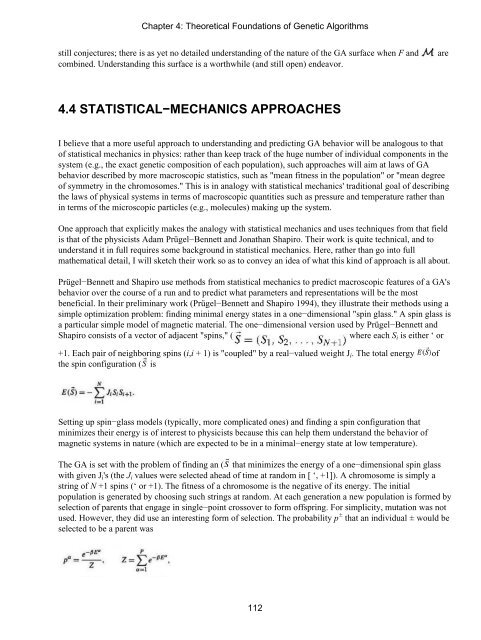An Introduction to Genetic Algorithms - Boente
An Introduction to Genetic Algorithms - Boente
An Introduction to Genetic Algorithms - Boente
You also want an ePaper? Increase the reach of your titles
YUMPU automatically turns print PDFs into web optimized ePapers that Google loves.
Chapter 4: Theoretical Foundations of <strong>Genetic</strong> <strong>Algorithms</strong><br />
still conjectures; there is as yet no detailed understanding of the nature of the GA surface when F and are<br />
combined. Understanding this surface is a worthwhile (and still open) endeavor.<br />
4.4 STATISTICAL−MECHANICS APPROACHES<br />
I believe that a more useful approach <strong>to</strong> understanding and predicting GA behavior will be analogous <strong>to</strong> that<br />
of statistical mechanics in physics: rather than keep track of the huge number of individual components in the<br />
system (e.g., the exact genetic composition of each population), such approaches will aim at laws of GA<br />
behavior described by more macroscopic statistics, such as "mean fitness in the population" or "mean degree<br />
of symmetry in the chromosomes." This is in analogy with statistical mechanics' traditional goal of describing<br />
the laws of physical systems in terms of macroscopic quantities such as pressure and temperature rather than<br />
in terms of the microscopic particles (e.g., molecules) making up the system.<br />
One approach that explicitly makes the analogy with statistical mechanics and uses techniques from that field<br />
is that of the physicists Adam Prügel−Bennett and Jonathan Shapiro. Their work is quite technical, and <strong>to</strong><br />
understand it in full requires some background in statistical mechanics. Here, rather than go in<strong>to</strong> full<br />
mathematical detail, I will sketch their work so as <strong>to</strong> convey an idea of what this kind of approach is all about.<br />
Prügel−Bennett and Shapiro use methods from statistical mechanics <strong>to</strong> predict macroscopic features of a GA's<br />
behavior over the course of a run and <strong>to</strong> predict what parameters and representations will be the most<br />
beneficial. In their preliminary work (Prügel−Bennett and Shapiro 1994), they illustrate their methods using a<br />
simple optimization problem: finding minimal energy states in a one−dimensional "spin glass." A spin glass is<br />
a particular simple model of magnetic material. The one−dimensional version used by Prügel−Bennett and<br />
Shapiro consists of a vec<strong>to</strong>r of adjacent "spins," ( where each Si is either ‘ or<br />
+1. Each pair of neighboring spins (i,i + 1) is "coupled" by a real−valued weight Ji. The <strong>to</strong>tal energy of<br />
the spin configuration ( is<br />
Setting up spin−glass models (typically, more complicated ones) and finding a spin configuration that<br />
minimizes their energy is of interest <strong>to</strong> physicists because this can help them understand the behavior of<br />
magnetic systems in nature (which are expected <strong>to</strong> be in a minimal−energy state at low temperature).<br />
The GA is set with the problem of finding an ( that minimizes the energy of a one−dimensional spin glass<br />
with given Ji's (the Ji values were selected ahead of time at random in [ ‘, +1]). A chromosome is simply a<br />
string of N +1 spins (‘ or +1). The fitness of a chromosome is the negative of its energy. The initial<br />
population is generated by choosing such strings at random. At each generation a new population is formed by<br />
selection of parents that engage in single−point crossover <strong>to</strong> form offspring. For simplicity, mutation was not<br />
used. However, they did use an interesting form of selection. The probability p ± that an individual ± would be<br />
selected <strong>to</strong> be a parent was<br />
112






